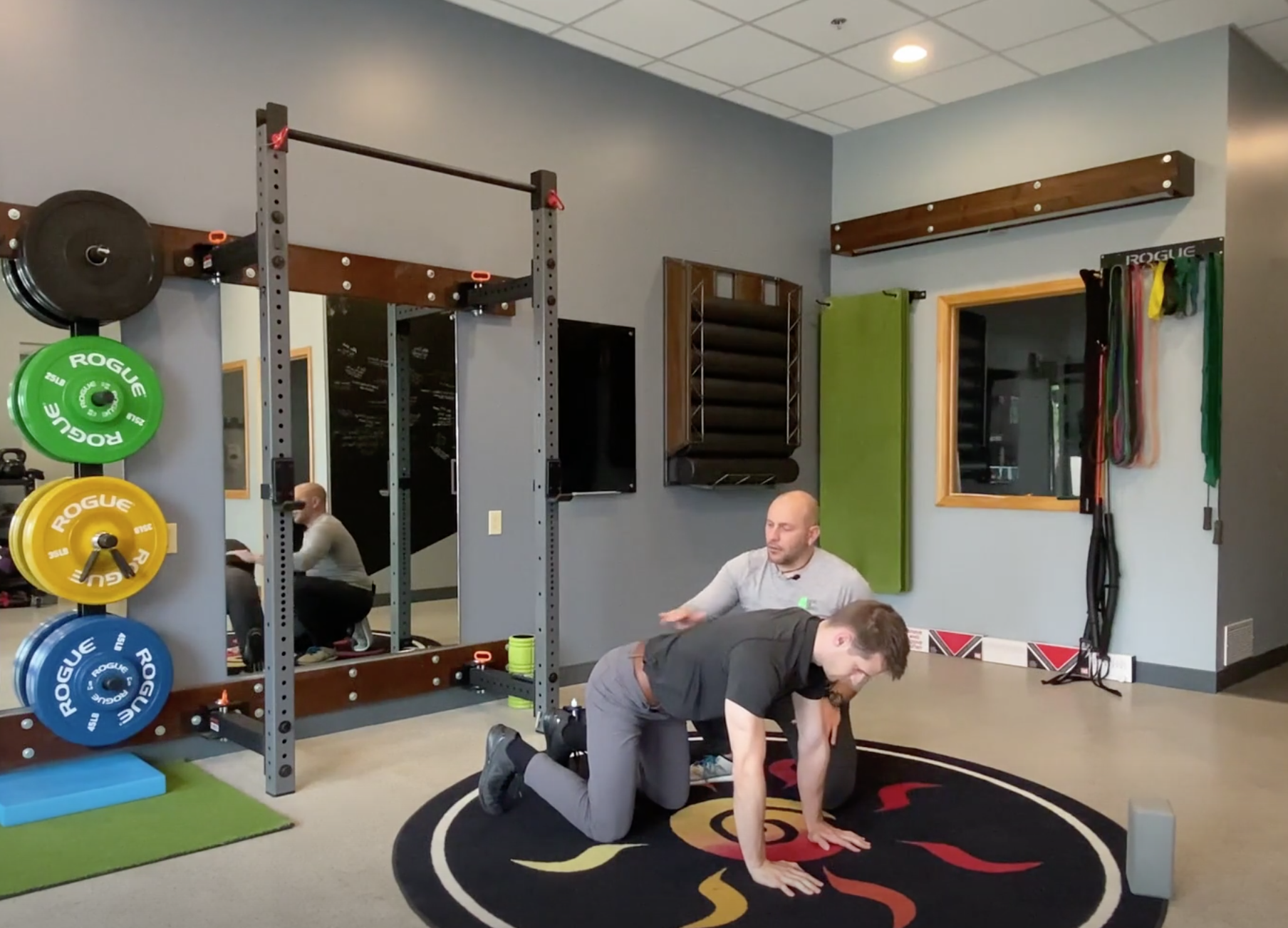Survival of the Fittest Part II
Written by Robert "Skip" George, DC, CCSP, CSCS SFMA
Dr. Robert "Skip" Georgeis a Chiropractor who owns and operates Optimum Fitness in La Jolla, CA. He is a chiropractor who specializes in rehabilitation and performance conditioning. He has a unique way of integrating the FMS into his practice. Below is the second article in a 3-part series, describing Functional Movement Systems and how he as a chiropractor using the system. The article below focuses on the SFMA, giving a brief summary and then describing its importance in treating painful issues in the clinical setting.
Survival of Fittest: Integrating Chiropractic, Rehabilitation, and Sports Performance Training
Part II: Move Well and Move Often: Introduction to the Selective Functional Movement
Assessment (SFMA)
By Robert "Skip" George, DC, CCSP, CSCS
In Part One of this series, I discussed the Functional Movement Screen (FMS) as one of the critical components of the Functional Movement System created by Gray Cook, MSPT and Lee Burton, PhD. The FMS ranks and rates the quality of movement, stabilization, balance, and symmetry using seven tests basic in providing a baseline for how and where to apply corrective exercise strategies and to re-test for their effectiveness. It is a most effective tool in discovering weak links in the kinetic chain and is essential for assessing injury risk and discovering pain during movement.
For chiropractors, if there is one primary motivator that initially brings patients to our offices it is pain! For example, in a typical case we will see is a patient who presents with lower back pain with or without sciatica and is given spinal manipulation perhaps with some kind of therapy and corrective exercise. Our pain relief success rate is legendary with this approach for many of these patients but for many others their problem can be stubbornly persistent and complex with chronic re-occurrences that frustrate the best efforts of doctor and patient.
Where the FMS is a screening tool, the Selective Functional Movement Assessment (SFMA) is a diagnostic tool. There are similarities and differences in the two screening procedures. Both the FMS and SFMA provide a complimentary means to assess cause and effect in addition to providing a rational for continuing care beyond the treatment of symptoms. The purpose of the SFMA is to assess the patient already in pain and to discover regional movement dysfunctions that cause local symptoms.
Regional interdependence is seen throughout the interconnection of the myofascial, neural and even circulatory systems as described by Thomas W. Meyers in his book “Anatomy Trains”. He states ”The muscle-bone concept presented in standard anatomical description gives a purely mechanical model of movement. It separates movement into discrete functions, failing to give a picture of the seamless integration seen in a living body. When one part moves, the whole body responds. Functionally, the only tissue that can mediate such responsiveness is the connective tissue.”
For years, chiropractors have been treating spinal misalignment or subluxations with manual therapy or adjustments often at the location of symptoms. Tom Hyde, D.C. is quoted in a Dynamic Chiropractic article by stating “Today there is more complexity with the description of subluxation. Now it can be defined as a more complex set of issues called spinal dysfunction”. And Gray Cook lists subluxation as part of a joint mobility dysfunction classification that contributes to pain and dysfunction caused by faulty movement patterns in addition to soft tissue and motor control components.
There is a complex interconnection of fascial, musculoskeletal, circulatory and neuromuscular systems that lead to a more complex understanding of dysfunction in not only the spine but the extremities as well. Our ability to heal our patients more effectively is dependent upon observing more clearly how these systems interconnect versus isolating one location or system by itself. For instance, are we too focused on chasing painful symptoms vs. addressing a more complex regional issue that relates to the location of pain? If a corrective exercise is given, how do we know that it fits the specific needs of the patient? Why do highly trained athletes experience non-contact injuries or patients seem to have chronic re-occurrences? And, are we piling fitness onto dysfunction? Often times the most important treatment strategy is knowing what exercises are actually harming our patients or reinforcing dysfunctional movement patterns and therefore should be eliminated.
Planning effective care needs an accurate starting place. A functional diagnosis that demonstrates posture and movement patterns is crucial. The SFMA is an excellent tool for this task. With practice, evaluating a patient with the SFMA takes less than two minutes. Once dysfunctions are discovered, a series of “breakout” movement tests are performed to determine the precise corrective strategy to employ.
There are seven movement assessments that comprise the SFMA, also known as the “BIG 7”. Caution! If these tests look simple or basic to you, you are right! However the interpretation and the meaning is not so obvious and will be revealed at the end of their brief descriptions.
The first is the Cervical Spine Movement Assessment with three components —flexion chin to chest, extension face parallel to ceiling, chin left and right to shoulders.
The second is the Upper Extremity Movement Pattern of the shoulder. Pattern One assesses internal rotation, extension and adduction of the shoulder and Pattern Two assesses external rotation, flexion, and abduction of the shoulder. This also includes a pain provocation test ie: Yocum’s impingement test.
The Third is the Multi-Segmental Flexion Assessment starting with patient standing erect and bending forward at the hips attempting to touch the finger tips to the toe tips.
The fourth is the Multi-Segmental Extension Assessment and tests for normal extension of the shoulders, hips and spine.
The fifth is the Multi-Segmental Rotation Assessment, and its objective is for testing normal rotational mobility in the neck, trunk, pelvis, hips knees and feet. All of these look just like part of a standard chiropractic/orthopedic evaluation, don’t they?
The sixth is the Single-Leg Stance Assessment and it evaluates independent stabilization of each leg with dynamic leg swings used as part of the test.
The seventh and last is the Overhead Deep Squat Assessment for bilateral symmetrical mobility of the hips, knees and ankles. With arms overhead, it also tests mobility of the shoulders and extension of the thoracic spine.
Unlike the FMS which uses a 0-3 point grading system, the SFMA places each movement assessment into one of four categories. These are Functional Non-Painful (FN), Functional Painful (FP), Dysfunctional Painful (DP), and Dysfunctional Non-Painful (DN). Since the SFMA is a tool for assessing patients with pain, which would be the most significant category for a given finding?
This is where the significance and meaning of an apparently simple testing or assessment tool is revealed! If you are thinking Dysfunctional Painful (DP) or Functional Painful (FP), it won’t be the significant finding in regards to regional interdependence and discovering the source of pain and dysfunction. Of course when painful findings are discovered, stop and treat the pain or injury with the best means possible.
It is the Dysfunctional Non-Painful (DN) pattern that will most often lead us to the source of a regional problem causing local pain. This is our starting place that takes us through a flow chart to “break-out” corrective exercise and treatment strategies. For example, the nagging lumbar pain that persists as mentioned at the beginning of this article may have its genesis in an asymmetry in an extremity pattern, postural and alignment issues outside of the lumbar spine or lumbar spine stability and motor control issues which may include inappropriate lumbar flexion instead of hip hinging. Essentially, start to look above or below the location of pain for the dysfunction that may be causing it.
The SFMA is taught and researched by Kyle Kiesel, PT, PhD., ATC, CSCS and Phil Plisky, PT, DSc, OCS, ATC, CSCS.. The SFMA is for licensed healthcare providers only including chiropractors, physical therapists, medical physicians and athletic trainers. Combining the SFMA and FMS for a Functional Movement System gives you a more comprehensive and powerful tool for risk assessment, injury prevention and treating pain caused by movement dysfunctions. In addition, your patients will experience a reason to continue with care beyond pain relief as it gives them a place to go with a road map from which to work from.
What could be better than providing lasting pain relief and corrective exercise care for a patient while progressing them to be more functional and stronger than when they entered our office?
By the way, there is one more component of the “Functional Movement System” in addition to the FMS and the SFMA. It is the Y-Balance Test and in essence is a “functional goniometer”. This is a great tool especially for post surgical rehab of knees and shoulders. More information can be found at Move2Perform.com.
In Part Three of this series, I will discuss the practical clinical applications of the FMS, SFMA, and the “Turkish Get Up” as a part of a continuum of care for your patients.
Robert "Skip" George, DC, CCSP, CSCS owns Optimum Fitness and Health in La Jolla, CA. and integrates chiropractic, rehabilitation, and sports performance training in his practice. He can be reached at Dr.George@SBCglobal.net
References:
1.The Functional Movement Screen Professional Training Manual by Gray Cook, MSPT, OCS, CSCS, Lee Burton, PhD, ATC, CSCS and Keith Fields, MS.
2. The Selective Functional Movement Assessment (SFMA) Training Manuel, An Integrated Model to Address Regional Interdependence, by Dr. Kyle Kiesel and Dr. Phil Pliskey
3.MOVEMENT: Functional Movement Systems, Gray Cook, MSPT, OCS, CSCS, with Dr. Lee Burton, Dr. Kyle Kiesel, Dr. Greg Rose, and Milo F. Bryant
4. Anatomy Trains, Thomas W. Meyers
Related Resources
-
Rock Climbing Warm Up
Posted by Curt M. Kippenberger DC
-
Breaking The Cycle
Posted by Michele Desser
-
What exactly is Dry Needling?
Posted by Gray Cook





